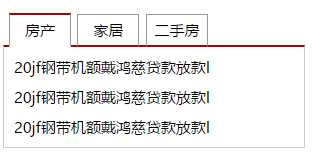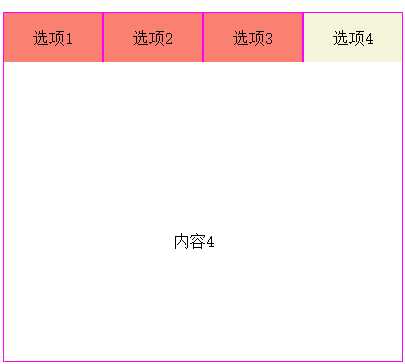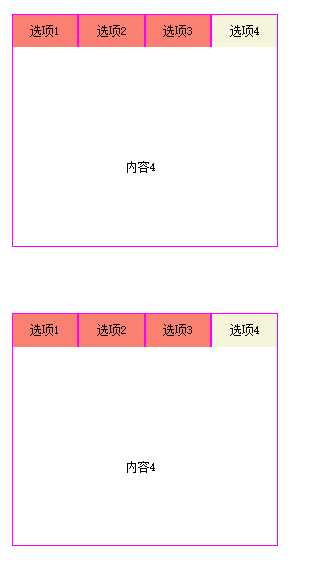标签:
前两种主要实现一个选项卡的切换,第三种使用闭包看书,构造函数实现多个选项卡的切换:
1.第一种实现实现效果为:

实现代码为:
<!doctype html>
<!DOCTYPE html>
<html lang="en">
<head>
<meta charset="utf-8"/>
<title>tab切换</title>
<style type="text/css">
* {
font: normal 15px "微软雅黑";
color: #000;
}
ul {
list-style-type: none;
padding-left: 5px;
margin-bottom: -2px
}
a {
text-decoration: none;
}
p {
display: block;
margin: 10px
}
li {
display: inline-block;
border: 1px solid #999;
border-bottom: 2px solid #a00;
background: #fff;
text-align: center;
width: 60px;
height: 30px;
margin: 0 1px;
line-height: 30px
}
ul .active {
border-top: 2px solid #a00;
border-bottom: 2px solid #fff;
}
#content {
margin: 0;
border: 1px solid #ccc;
border-top: 2px solid #a00;
width: 300px
}
#content div {
display: none
}
#content .active {
display: block;
}
</style>
</head>
<body>
<div>
<ul>
<li name="a" onclick="tab(this)" class="active"><a href="#">房产</a></li>
<li name="a" onclick="tab(this)"><a href="#">家居</a></li>
<li name="a" onclick="tab(this)"><a href="#">二手房</a></li>
</ul>
<div id="content">
<div class="active" name="con">
<p>20jf钢带机额戴鸿慈贷款放款l</p>
<p>20jf钢带机额戴鸿慈贷款放款l</p>
<p>20jf钢带机额戴鸿慈贷款放款l</p>
</div>
<div name="con">
<p>nvmllllmlddnlv来的都来l</p>
<p>戴绿帽没vvmdslnv</p>
<p>的女凯迪拉克vk</p>
</div>
<div name="con">
<p>发V</p>
<p>叉路口积分卡很多可没</p>
<p>奉公如法</p>
</div>
</div>
</div>
<script type="text/javascript">
var li_arr = document.getElementsByTagName("li");
var div_arr = document.getElementsByName("con");
var len = li_arr.length;
function tab(obj) {
for (var i = 0; i < len; i++) {
if (li_arr[i] == obj) {
li_arr[i].setAttribute("class", "active");
div_arr[i].setAttribute("class", "active");
} else {
li_arr[i].setAttribute("class", "");
div_arr[i].setAttribute("class", "");
}
}
}
</script>
</body>
</html>
2.第二种实现效果为:

主要实现代码如下:
<!DOCTYPE html>
<html lang="en">
<head>
<meta charset="UTF-8">
<title>Title</title>
<style>
*{padding: 0; margin: 0; box-sizing: border-box}
div{ width: 70%; margin: 100px auto}
ul{list-style: none; overflow: hidden}
.tabs li{
float: left;
width: 100px;
text-align: center;
line-height: 30px;
background: #f60;
border: 1px solid #f60;
border-bottom: none;
cursor: pointer;
}
.tabs li:hover{
background: #fff;
}
.tabs li.active{
background: #fff;
}
.content{
position: relative;
width: 400px;
height: 300px;
border: 1px solid #f60;
border-top: none;
}
.content li{
width: 100%;
height: 100%;
position: absolute;
padding: 10px;
display: none;
}
</style>
</head>
<body>
<div>
<ul class="tabs" id="tabs">
<li class="active">选项1</li>
<li>选项2</li>
<li>选项3</li>
<li>选项4</li>
</ul>
<ul class="content" id="content">
<li style="display: block">内容1</li>
<li>内容2</li>
<li>内容3</li>
<li>内容4</li>
</ul>
</div>
<script>
// 普通方法实现一个选项卡切换
var tabs =document.getElementById("tabs");
var tablist = tabs.children;
var content =document.getElementById("content");
var conlist = content.children;
for(i=0;i<tablist.length; i++){
tablist[i].index = i; // tablist[i]增加index属性 ,属性值为该项的下标
tablist[i].onclick = function(){
for(j=0;j<conlist.length;j++){
tablist[j].className ="";
conlist[j].style.display = "none";
}
this.className = "active";
conlist[this.index].style.display = "block";
}
}
</script>
</body>
</html>
3. 第三种实现效果为:
在第二种实现方式的基础上,实现多个选项卡的切换,使用了闭包函数

主要实现代码:
<!DOCTYPE html>
<html lang="en">
<head>
<meta charset="UTF-8">
<title>Title</title>
<style>
* {
margin: 0;
padding: 0;
box-sizing: border-box;
}
div {
margin: 100px;
}
ul {
list-style: none;
overflow: hidden;
}
.tabs li {
float: left;
width: 100px;
height: 50px;
line-height: 50px;
text-align: center;
border: 1px solid fuchsia;
background: salmon;
border-bottom: none;
cursor: pointer;
}
.tabs li.active {
background: beige
}
.content {
position: relative;
width: 400px;
height: 300px;
border: 1px solid fuchsia;
border-top: none;
}
.content li {
width: 100%;
height: 100%;
position: absolute;
display: none;
padding: 170px;
}
</style>
</head>
<body>
<div>
<ul class="tabs" id="tab1">
<li class="active">选项1</li>
<li>选项2</li>
<li>选项3</li>
<li>选项4</li>
</ul>
<ul class="content" id="content1">
<li style="display: block">内容1</li>
<li>内容2</li>
<li>内容3</li>
<li>内容4</li>
</ul>
</div>
<div>
<ul class="tabs" id="tab2">
<li class="active">选项1</li>
<li>选项2</li>
<li>选项3</li>
<li>选项4</li>
</ul>
<ul class="content" id="content2">
<li style="display: block">内容1</li>
<li>内容2</li>
<li>内容3</li>
<li>内容4</li>
</ul>
</div>
<script>
function tab(tabid, contentid){
var tabul = document.getElementById(tabid);
var tablists = tabul.getElementsByTagName("li");
var contentul = document.getElementById(contentid);
var conlists = contentul.getElementsByTagName("li");
for(i=0;i<tablists.length; i++){
tablists[i].onclick = function(i){ //闭包函数
return function (){
for(j=0;j<conlists.length;j++){
tablists[j].className ="";
conlists[j].style.display = "none";
}
this.className = "active";
conlists[i].style.display = "block";
}
}(i);
}
}
tab("tab1", "content1");
tab("tab2", "content2");
</script>
</body>
</html>
标签:
原文地址:http://www.cnblogs.com/caozong/p/5777893.html